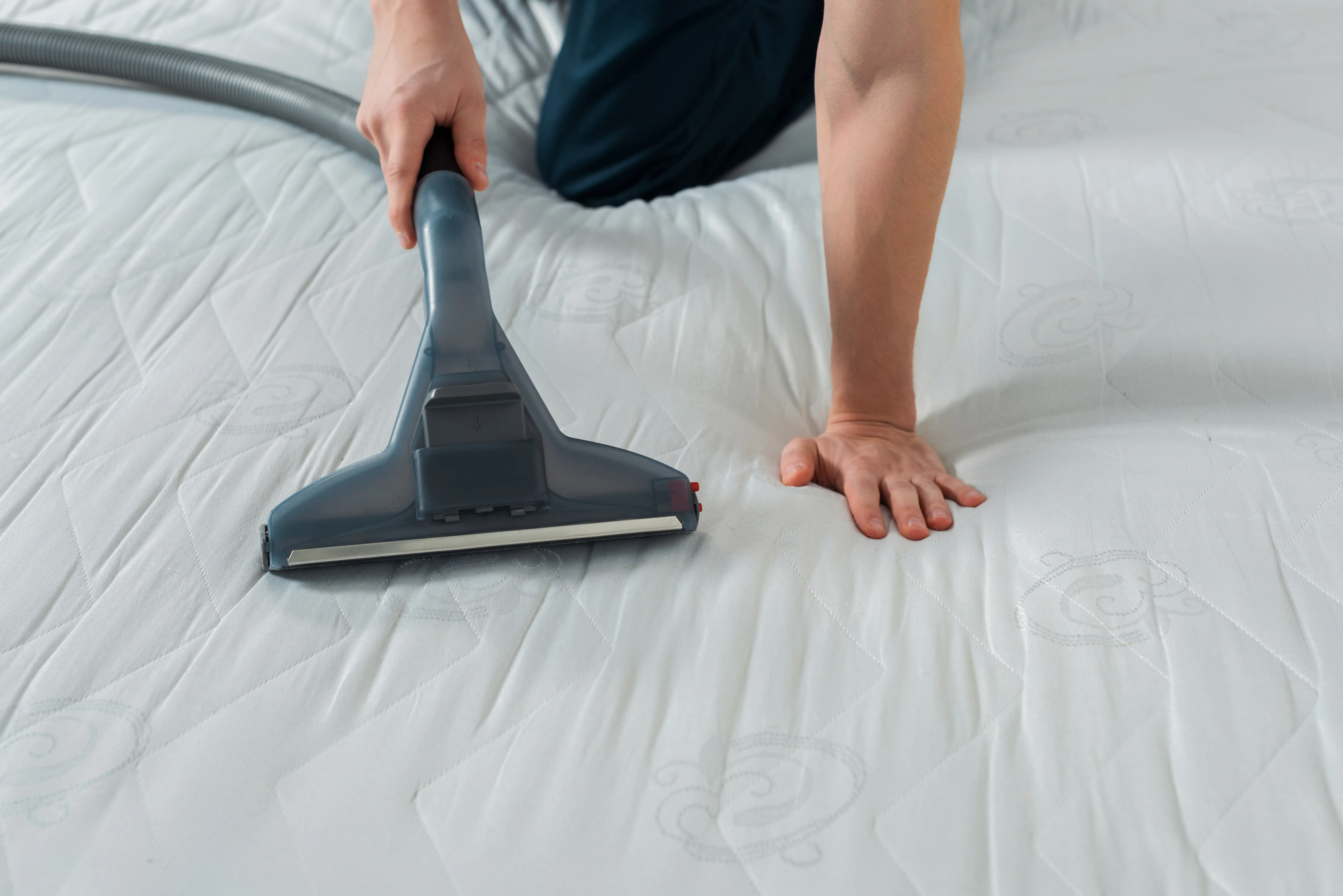A clean mattress isn't just a luxury, it's an essential part of a healthy and peaceful night's sleep. Over time, our mattresses accumulate dust mites, dead skin cells, and even sweat, creating a breeding ground for allergens and odors that can disrupt our slumber and impact our overall well-being.
That's why this article is your ultimate guide to keeping your sleeping surface fresh, odor-free, and comfy. We'll walk you through the detailed instructions on how to clean a mattress like a pro, along with preventative steps to keep it pristine for longer.
Why You Should Regularly Clean Your Mattress?
Every night, your skin and hair shed, and you lose fluid, which is absorbed by the mattress, pillow, and bedding. All of this makes the mattress an ideal breeding ground for bed bugs, dust mites, germs, and fungus.
Over time, this build-up can start emitting a strange odor, a sign of the build-up thriving on your mattress. Worse, poor mattress hygiene can aggravate allergies, nasal congestion, and even skin diseases. Sleepless nights filled with sneezing, itching, and discomfort are never welcome guests in your life.
The good news is, that taking control of your mattress cleanliness can bring a wave of positive changes to your health and sleep quality.
Benefits Of Clean Mattress
Regularly cleaning your mattress offers a variety of benefits that go beyond just aesthetics. Consider it an investment in your health, and sleep quality.
- Hygiene: Cleaning removes the dust mite feast, allergens, and germs that camp out on your mattress, creating a cleaner, healthier sleep environment.
- Durability: Proper care, including regular cleaning, extends your mattress's lifespan. As, removing dirt and sweat prevents wear and tear, keeping your mattress supportive and luxurious for years to come.
- Freshness: Cleaning eliminates stains, smells, and perspiration residues from your mattress, leaving it smelling clean and welcoming.
- Avoiding Dust Mites: Dust mites are microscopic insect-like bugs that eat your skin cells at night. Because you shed millions of skin cells each week, the average mattress has tens of thousands of dust mites looking for their next meal, this is why you should regularly clean your mattress.
Stain Removers
There are several types of stains and they can vary from simple water damage stains to much harder stains like blood, sweat, or food stains. Treating them incorrectly can set the stain permanently, so choosing the right approach is crucial. Therefore, each stain should be handled correctly to achieve optimum results.
Sweat Stains:
Combine 8 ounces of hydrogen peroxide and 3 teaspoons of baking soda in a mixing bowl, and use this spray mixture to remove sweat stains.
Deodorizing:
Sprinkle baking soda on top of the mattress and let it sit for as long as possible, ideally in direct sunshine.
Urine:
Fill the spray bottle halfway with vinegar and water. Wipe the extra urine with a dry, clean towel without scrubbing, since this will force the urine further into the mattress.
Blood:
In a mixing basin, combine two parts water and one part baking soda.
Disinfecting:
Use a reliable fabric softener and any handy washing detergent.
Fragrance:
Make a mixture combining two parts hydrogen peroxide, one part baking soda, and a few drops of essential oils of your liking in a spray bottle.
How To Clean Your Mattress
This comprehensive guide will walk you through every step of cleaning your mattress, even if it's showing signs of wear and tear.
Step 1: Strip the Bed and Wash Bedding
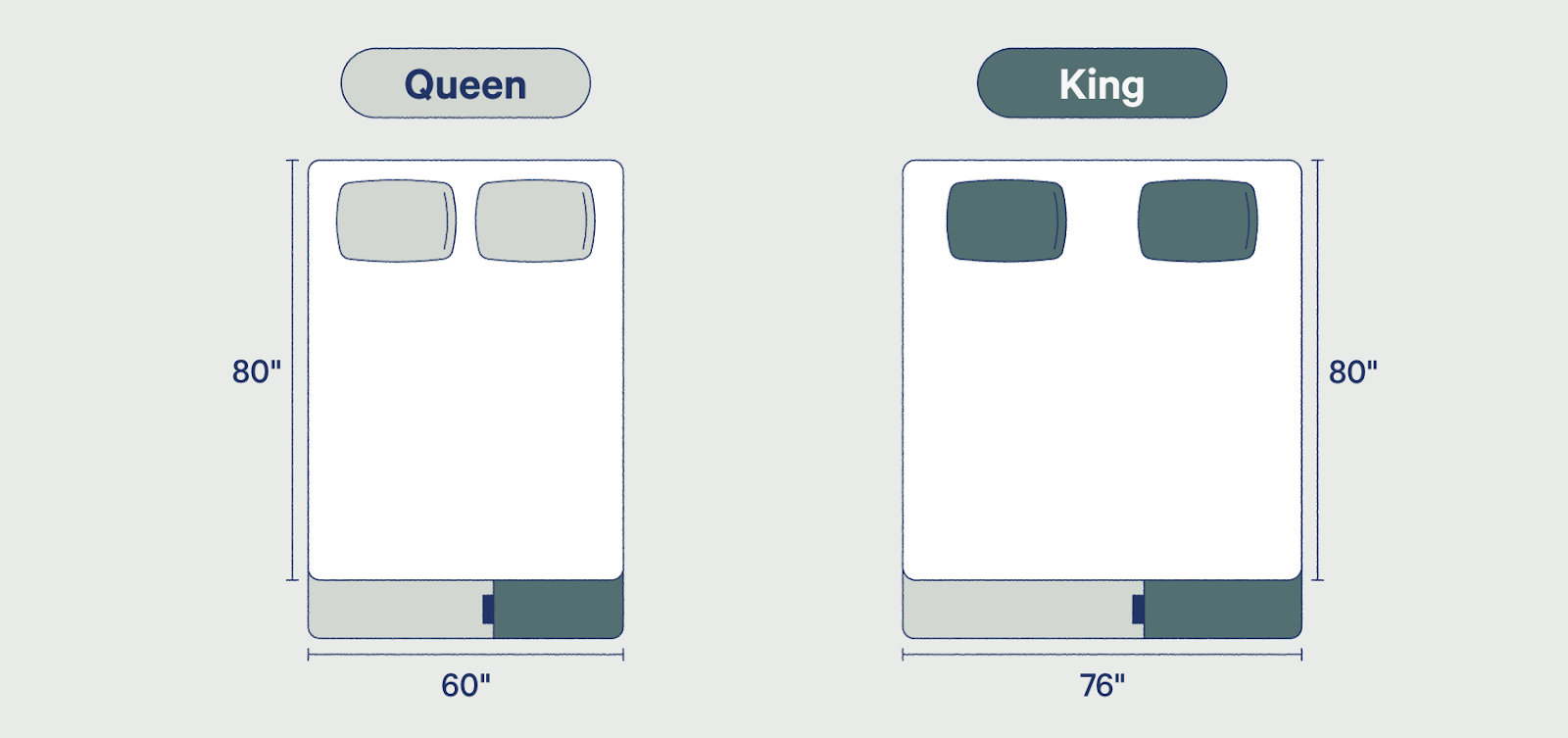
Remove all sheets, pillowcases, and mattress covers and wash them in hot water to effectively eliminate dust mites. Check care labels before washing pillows.
Step 2: Assess Damage
The best technique to clean a mattress depends on its condition and the stains. The method used for normal mattress cleaning will differ from that used to remove a spill or stain. You should carefully inspect your mattress for stains, discoloration, odors, stains from drinks, food, oil, urine, and other potential issues.
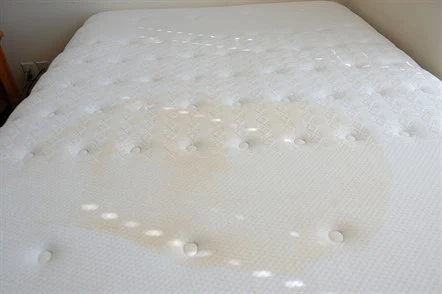
If it’s simply water damage, air out the mattress thoroughly, ensuring complete dryness before use. Drying time may vary depending on severity.
Step 3: Gather Cleaning Supplies
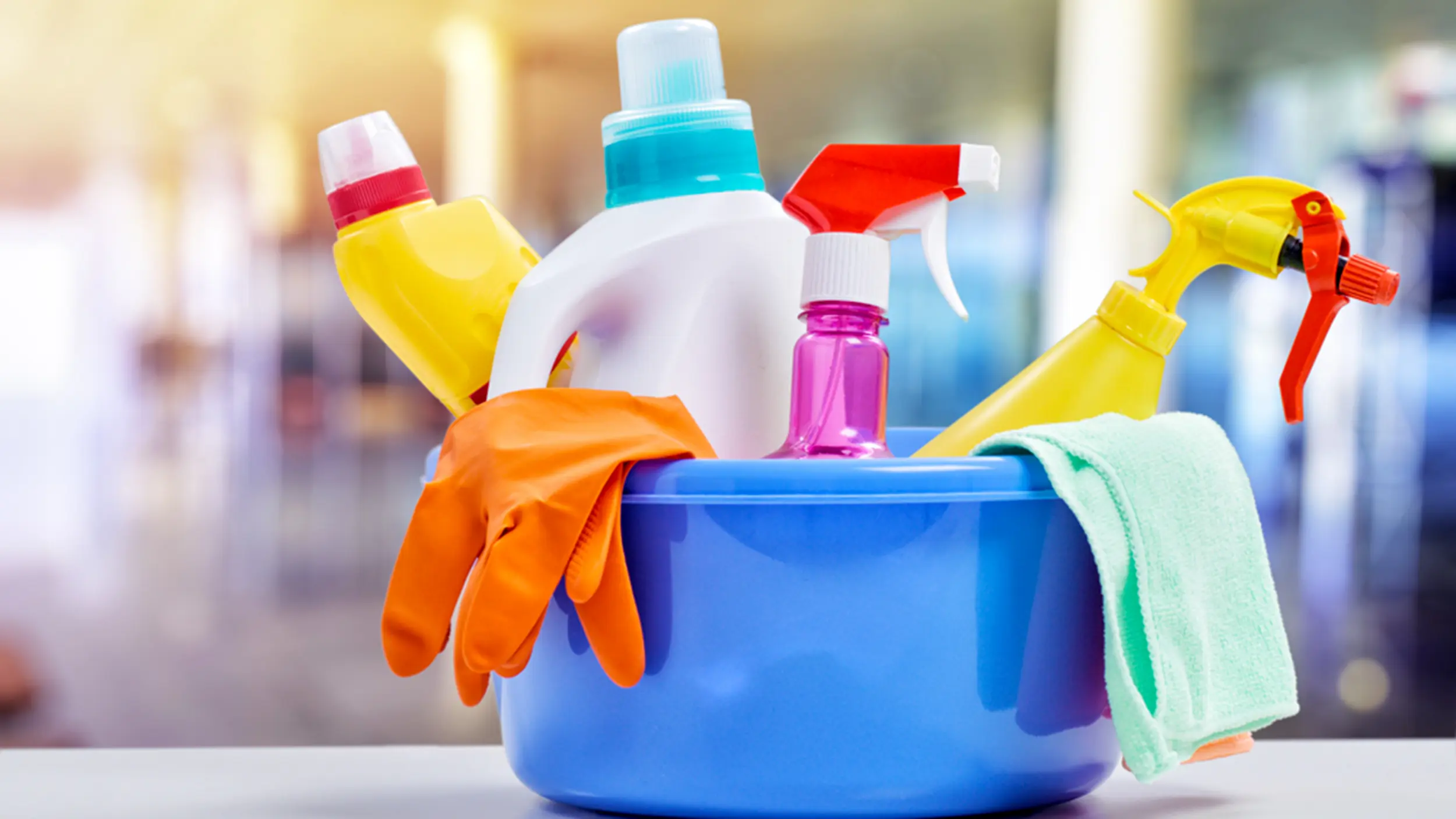
Before you begin to clean your mattress, there are a few things you'll need. The list of cleaning products we suggest is below:
- Vacuum cleaner with upholstery attachment
- Dish soap or detergent
- Baking soda
- Clean cloths
- Warm water
- Cleaning spray or natural alternatives like vinegar or enzyme cleaners
Step 4: Vacuum Thoroughly
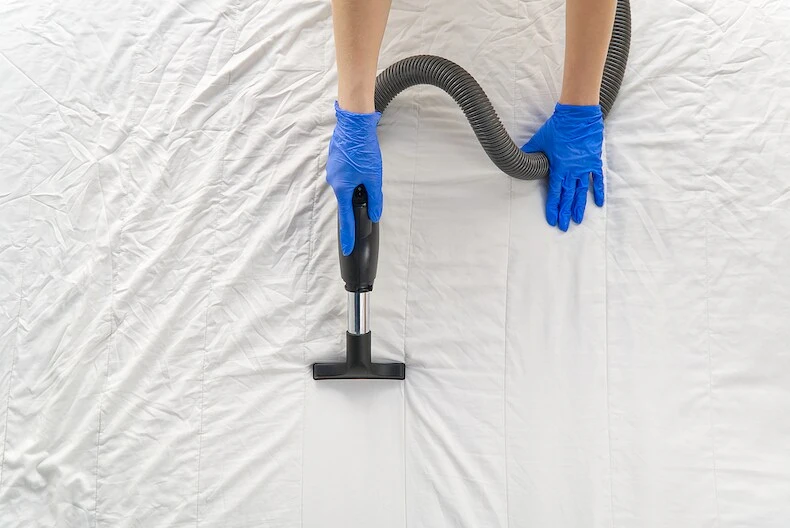
Vacuum the entire mattress surface, including sides and seams, using the upholstery attachment. Pay special attention to crevices where dust and debris can hide.
Step 5: Tackle Stains
Now it's time to tackle those pesky stains with some gentle spot-cleaning. Remember, never soak your mattress or apply cleaning solutions directly, especially on memory foam. Instead, approach with caution and follow the golden rule of 'less is more.'
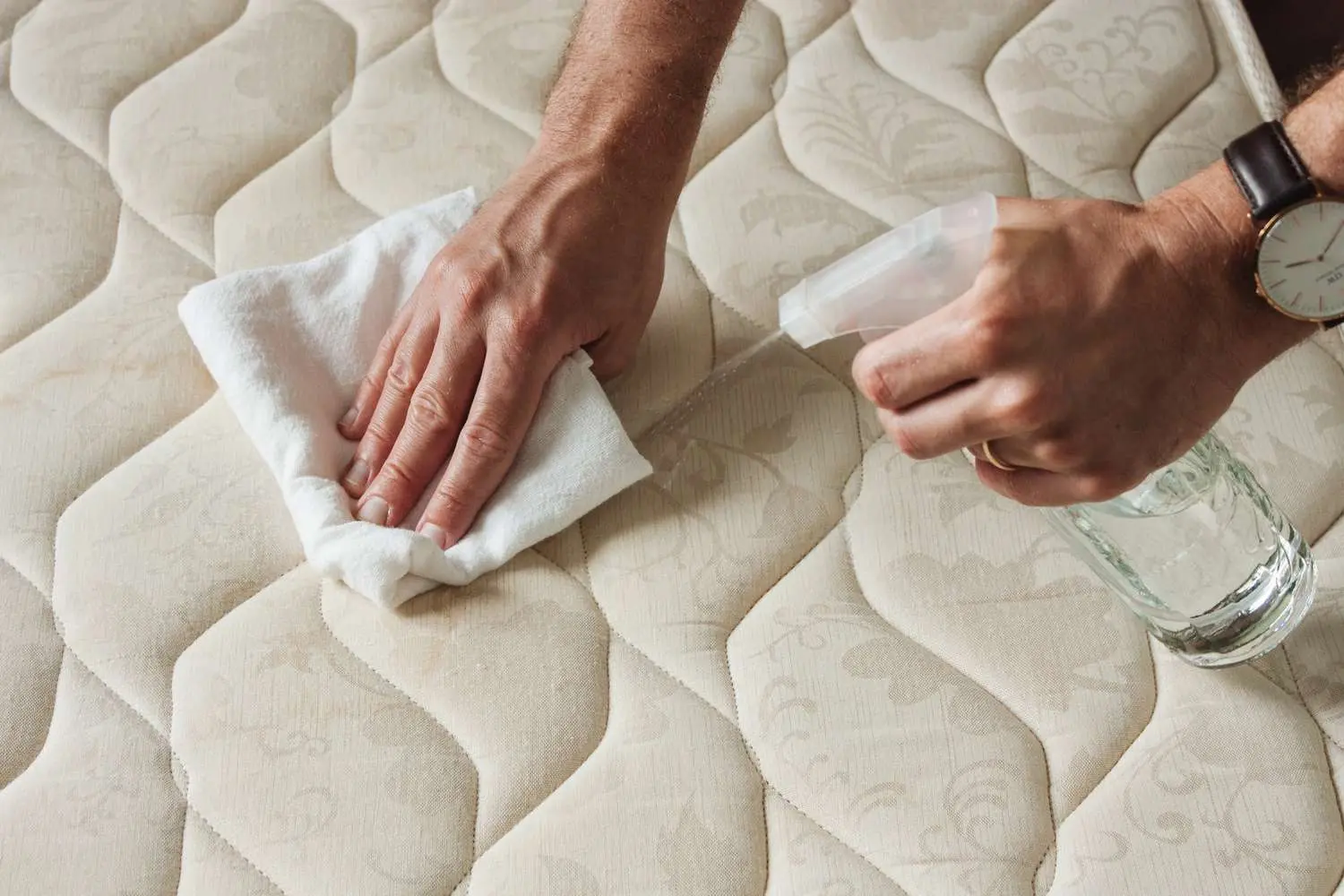
Choose a stain remover suitable for the stain, as discussed in the section above. Spray the area lightly, then dampen a clean white towel and gently blot the stain with minimal moisture.
This approach works well for removing blood, perspiration, vomit, pee, and even coffee spills.
Step 6: Refresh with Baking Soda and Vacuum
Once any apparent stains have been removed and the mattress cover has had time to dry, sprinkle a thin coating of baking soda, around 1/2 cup for a twin mattress, and 1 cup for a queen/king all over the mattress. Baking soda is useful in both absorbing moisture and eliminating odors.
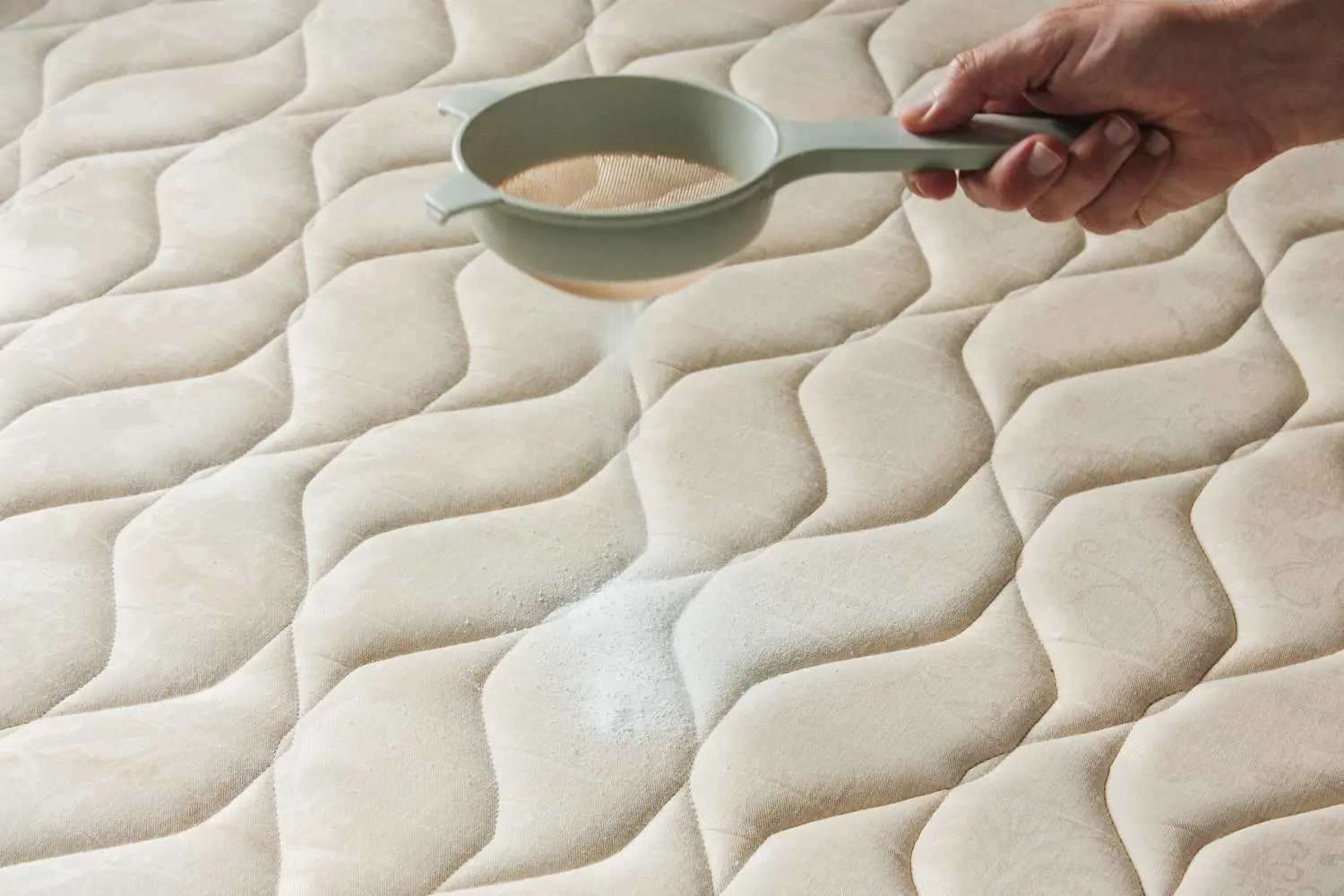
Let the baking soda sit on the mattress for a few hours, around 2-4 hours, or 4-6 hours for a larger mattress. then simply vacuum it off to reveal a refreshed and revitalized mattress. To improve ventilation, try opening the windows in your bedroom.
Step 7: Air The Mattress
While optional, airing out your mattress offers additional perks, like removing any lingering moisture, cleaning product odors, and boosting freshness.
To address these and allow the fabric to breathe, let your mattress air out for a few hours with your bedroom window open.
Step 8: Flip it Over
With one side sparkling clean, it's time to tackle the other. Simply flip your mattress over and repeat the steps.
Remember, flipping isn't just for deep cleaning, it's a regular maintenance routine that helps your mattress wear evenly and last for years.
Pro Tip: Scent your Mattress
For a calming sleep, try a few drops of eucalyptus, lavender, peppermint, or lemon essential oils directly on your pillowcase or diffusing them in the air. These natural fragrances can promote relaxation and improve your sleep quality.
For a more targeted approach, consider a fragrance spray, which is described above, or a room spray. While both can work, we especially recommend the FluffCo Turn Down Room Spray.
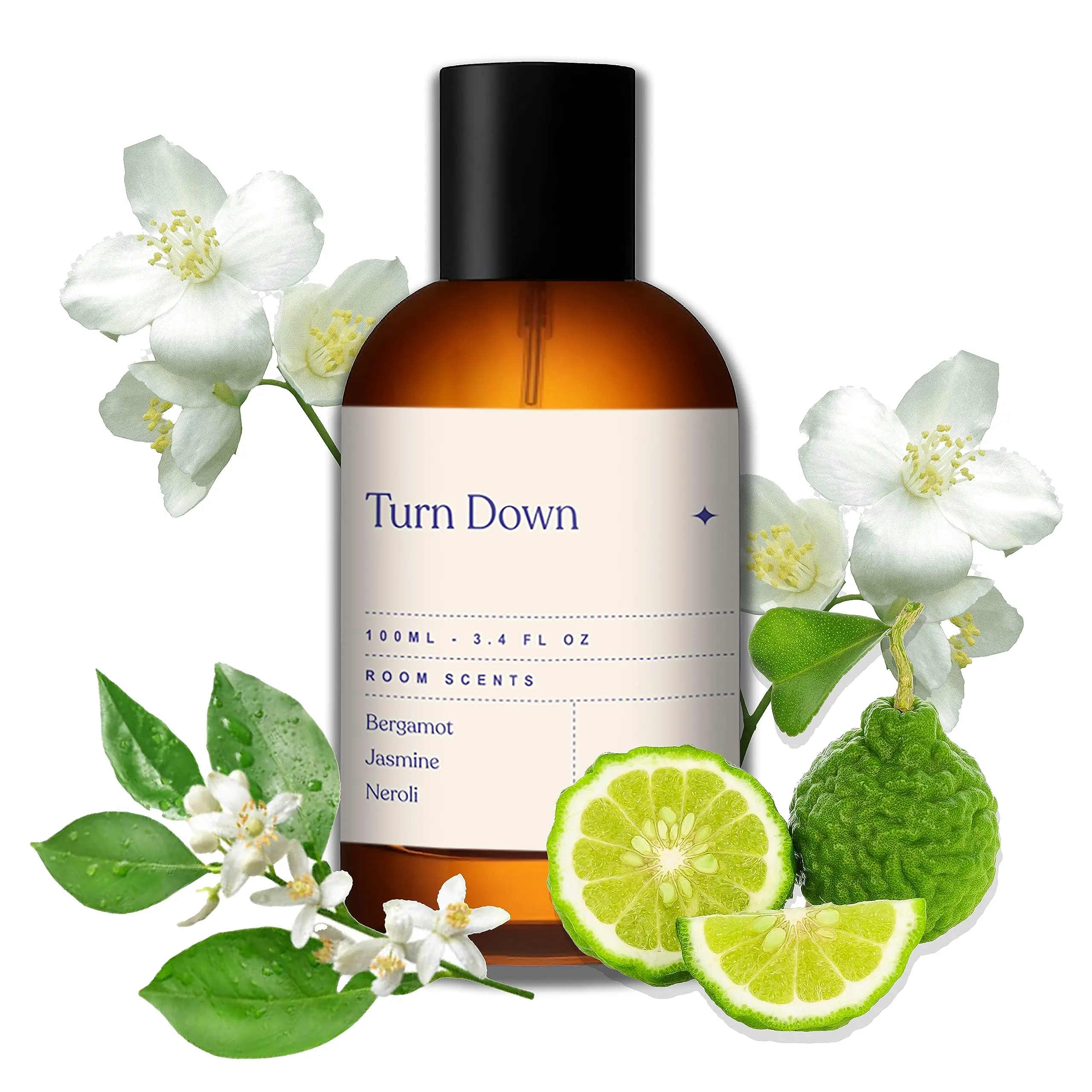
How To Protect Your Mattress
Use a Mattress Cover: Invest in a waterproof and breathable mattress protector to keep spills, stains, and dust mites at bay.
Flip the Mattress: Rotate your mattress regularly to promote even wear and prevent the accumulation of body imprints.
Air Out the Mattress: Take off all the bedding and give the mattress some air every few months. To enhance air circulation and avoid moisture accumulation, open windows or turn on a fan.
Avoid Eating or Drinking on the Mattress: By avoiding eating or drinking on the mattress, you can reduce the possibility of spills and stains.
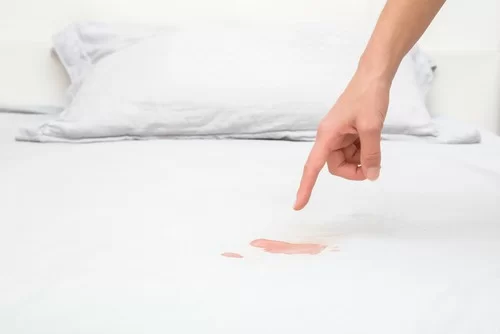
Do’s and Don’ts of Mattress Cleaning:
Do:
- Regularly remove and wash bedding: While you clean the mattress, take off the covers, pillowcases, and sheets and wash them in the washing machine. All bedding should be washed in hot water to get rid of dust mites. Don't forget to check care labels before laundering pillows.
- Spot clean stains gently: The side of the mattress where you lie most is more prone to discoloration. If you wipe these stains as soon as you wake up, they might not be a big deal, but if they stay on your mattress for a long period, they will eventually become difficult to get rid of and might even affect its color.
- Consider enzyme cleaners: For tougher stains like pet accidents or vomit, the compounds in enzyme cleansers initiate a chemical process that degrades the microorganisms found in soiled mattresses, upholstery, and carpets. Apply the enzyme remover to the stain and let it sit for one hour, or up to 48 hours if the stain is particularly stubborn. Use a damp microfiber cloth to wipe, then continue the process until the stain is gone. After the mattress has dried for as long as it takes, vacuum it.
- Flip and rotate regularly: Our bodies weigh differently in different places on a mattress, and so do different people. Once a season, alternate between flipping and turning your mattress to guarantee even wear and tear over time. Turn your mattress over in the spring, then again in the summer.
Don’t:
- Soak the mattress: Mattresses and water do not get along. While box springs can handle some moisture, memory foam mattresses are especially vulnerable. Liquids trapped in their cellular structure pose a serious risk of damage. So, for spot cleaning, use minimal stain remover and avoid water altogether.
- Use harsh chemicals: Harsh chemicals like bleach are extremely harsh to use on a mattress's fragile fibers because of how acidic it is. In the end, bleaching your bed might damage the fibers and cause the material to deteriorate. A weakened fabric ultimately increases the possibility of rips and holes, which can limit the life of your mattresses.
- Ignore persistent stains or odor: Stubborn stains and lingering odors can be a mattress nightmare. If you're unsure how to tackle them, consider seeking help from a professional mattress cleaning service. Go for a steam-based cleaning method, as harsh chemicals can irritate some people.
FAQs
How frequently should I wash my mattress?
We generally recommend cleaning your mattress every 6 months. Of course, if you spill something, you should clean it immediately to prevent the stain from setting in. Using a good-quality mattress protector will reduce the need for frequent cleaning.
Can I clean my mattress using a steam cleaner?
Yes, a steam cleaner is an excellent way to clean and disinfect a traditional mattress. Just make sure not to soak the mattress with water. Allow it to dry completely before sleeping on it again.
How can I keep my mattress smelling fresh in between cleanings?
Baking soda is a great option for quick deodorizing. Simply sprinkle baking soda on the mattress, let it sit for a minimum of 2 hours, and then vacuum it up. Baking soda naturally neutralizes odors.
Can I wash my mattress?
No, you should never pour cleaning solutions directly onto the mattress. Instead, apply the solution with a clean towel and then remove it. The best stain removal treatment depends on the type of stain.
Is it necessary to hire a professional mattress cleaner?
While you can clean your mattress yourself, improper methods can damage it. Hiring a reputable professional can ensure thorough cleaning, extend its lifespan, and alleviate allergies or odors. We recommend professional cleaning once every 12 months, depending on how frequently you use your mattress.
Is it ok to use bleach to remove urine stains from my mattress?
Cleaning mattresses with bleach is not advised. Bleach can damage, discolor, or void the warranty. For urine stains, consider using an enzyme cleaner specifically designed for biological stains.
Can you clean a moldy mattress and should you?
Leaving mold untreated can cause serious health problems and further damage your mattress. However, it can be cleaned easily if caught early. Effective cleaning solutions include vinegar, rubbing alcohol or hydrogen peroxide mixed with water.
Can you use bleach to remove yellow stains from mattresses?
Cleaning mattresses with bleach to remove yellow stains is not advised. Bleach might damage, discolor, or void the guarantee on your mattress. To choose the best cleaning and protection products for your mattress, follow the steps mentioned above.
Can you clean a mattress with dishwashing liquid?
While it's possible to use dishwashing liquid, it's not the most ideal option. If you have limited alternatives, combine it with lukewarm water and gently dab at the stain. However, enzyme cleaners or professional mattress cleaning solutions are generally more effective.
How do you sanitize and disinfect a mattress?
You can use natural home cleansers or professional sprays designed to eradicate bacteria and disinfect sweat stains. Avoid bleach-containing products, as they can harm mattress fibers. Enzyme cleaning sprays are also a good option.
Can I "Clean" Bed Bugs from My Mattress?
If the infestation is not severe, you can vacuum your mattress to remove or kill bed bugs. Then, cover it with a bedbug-proof encasement for protection.
Jessica H.
Jessica is a reviewer, writer, and sleep enthusiast at Sleepiverse. Jessica graduated with her master's degree in Nursing research and education. She is a registered nurse and currently works in the Intensive Care Unit. Since becoming a nurse, Jessica has worked the night shift, which means a disrupted sleep schedule. Knowing she needed to function at her best while caring for patients at night, she spent a lot of time researching how to sleep well with a difficult schedule.


